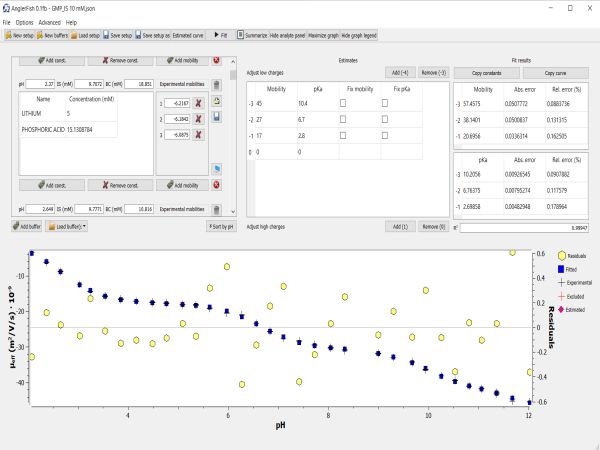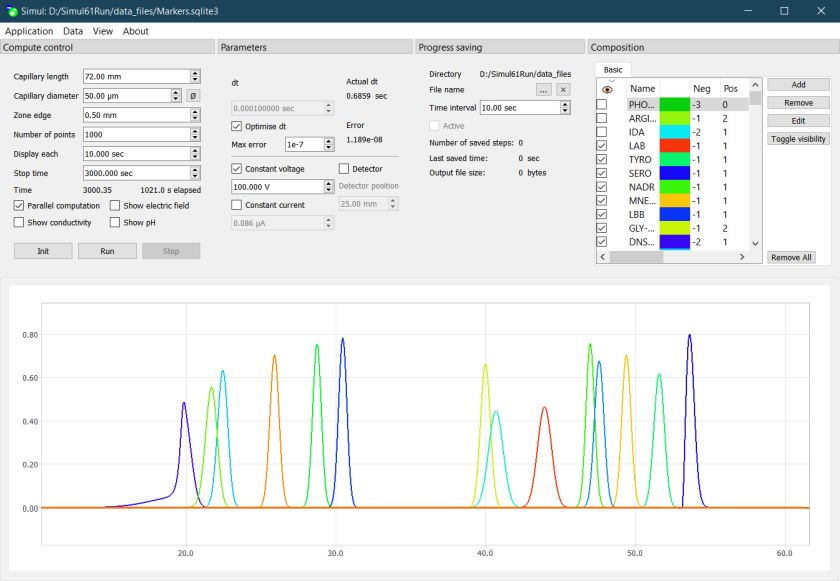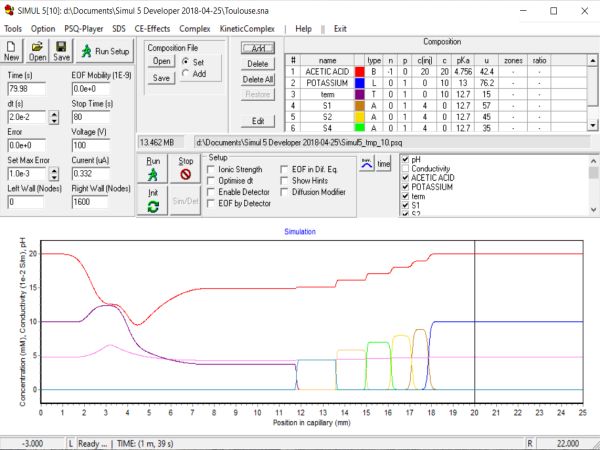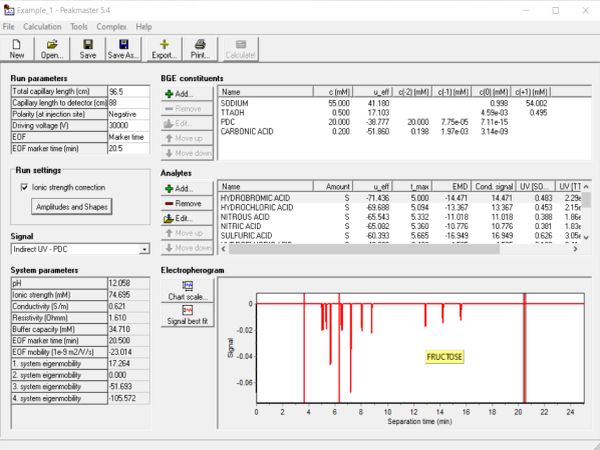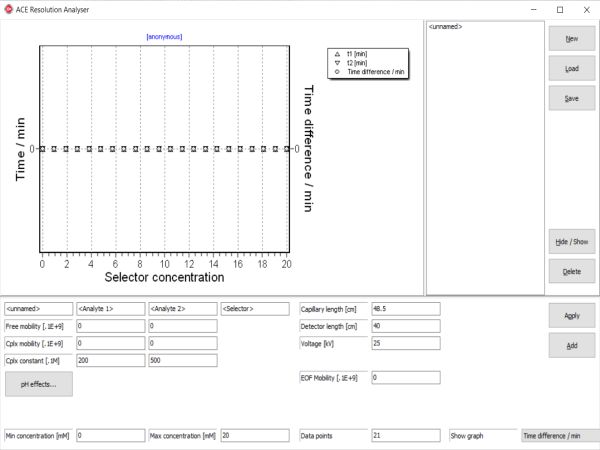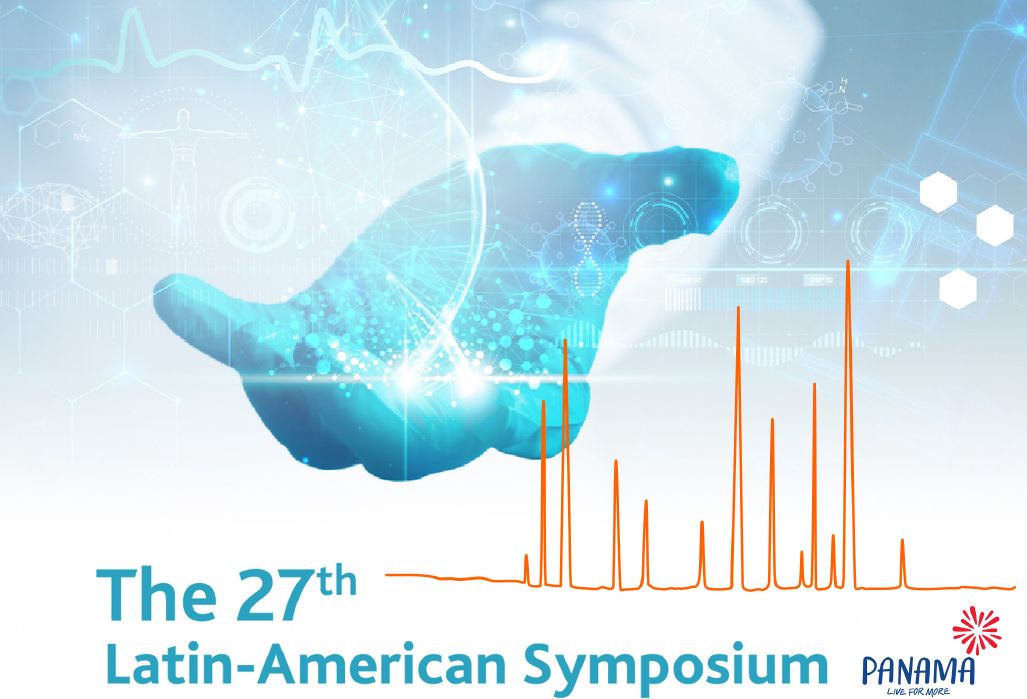Next generation of our software PeakMaster with full complexation equilibria implemented and a refined user interface.
PeakMaster predicts parameters of background electrolytes and analyte peaks in capillary zone electrophoresis. PeakMaster is useful for finding optimal background composition in CZE. Many of users uses it just as as a powerful pH calculator, too. PeakMaster is now available in version 6 - "New Generation" - which can evaluate affinity capillary electrophoresis with interacting agents (such as chiral selectors) of nearly any kind of complexity.
How does PeakMaster work?
First you input the composition of the background electrolyte containing any number of constituents, which can be weak or strong acids or bases or amphoteric electrolytes like aminoacids or peptides. The maximum valence (either positive or negative) is four in version 5.3 and unlimited in version 6. The resulting BGE is allowed to be highly acidic or alkaline (usable pH range from 0 to 14).
Optionally you input the names of the analyte ions in the injected sample and some experimental characteristics of your equipment. PeakMaster includes a database based on Takeshi Hirokawa's tables with the data of many ions. PeakMaster further uses Onsager-Fuoss correction of mobilities for ionic strength and Debye-Hückel calculations of activity coefficients.
After clicking the Calculate button, PeakMaster performs the following actions:
-
It calculates BGE characteristics
- pH
- ionic strength
- conductivity
- buffer capacity
- concentrations of the individual ionic forms of BGE constituents
-
It calculates electrophoretic characteristics of the analytes
- effective mobility
- dispersion tendency
- direct detection signal
- conductivity detection signal
- indirect UV detection signal
-
It displays expected electropherograms
-
It calculates system eigenmobilities
What are the system eigenmobilities?
The existence of system eigenmobilities indicates that certain entities in the electrophoretic system move with such mobilities in the driving electric field. Generally, none of the system eigenmobilities is exactly zero. At least one of the eigenmobilities is almost always very close to zero and is a cause for the injection zone (or water dip, or water gap).
It must be, however, realized that the position of the injection zone is not equivalent to a position of an EOF neutral marker and in some BGEs it can even be substantially different. In such BGEs there is no injection zone that can serve as the marker of the EOF! In rather acidic or alkaline BGEs or in BGEs containing multiple coions or in BGEs with a multivalent co-constituent there are one or more eigenmobilities different from zero. System eigenmobilities cause either
An appearance of system peaks
A resonance phenomenon
System peaks appear in the electropherogram as usual PeakMaster but they do not belong to any analyte or a matrix component. They are a result of injection and movement of ions in the BGE. Even if nothing else but a diluted BGE is inhected system peaks can be observed.
Due to the resonance, an amplified response of indirect UV detection or conductivity detection at the site of the analyte should be expected. The indirect signal of the analyte is then no longer proportional to its quantity. Further, serious anomalous dispersion of the peak should be expected.
We have published a series of papers dealing with these interesting phenomena
Stedry M, Jaros M, Gas B: J. Chromatogr. A 2002, 960, 187-198
Stedry M, Jaros M, Vcelakova K, Gas B: Electrophoresis 2003, 24, 536-547
Stedry, M, Jaros, M, Hruska, V, Gas, B: Electrophoresis 2004, 25, 3071-3079
Jaros M, Hruska V, Stedry M, Zuskova I, Gas B: Electrophoresis 2004, 25, 3080-3085
Features of PeakMaster
The BGE can contain any number of constituents. The constituents of the BGE and analytes can be weak or strong acids or bases or amphoteric electrolytes. Weak interactions among constituents - the affinity capillary electrophoresis mode - are allowed (since version 6). Then:
pH and buffer capacity of the BGE is calculated
Detection signals can be displayed as electropherograms
For depiction of electropherograms we utilize Haarhoff-van der Linde (HVL) function, so the peaks look close to reality.
PeakMaster 6 (64bit) | v. 6.0g3
Windows version. The program is packed in a zip file. Portable - simply unzip and run PeakMasterNG.exe.
Download
PeakMaster 6 (32bit) | v. 6.0g3
Windows version. The program is packed in a zip file. Portable - simply unzip and run PeakMasterNG.exe. We strongly recommend users with 64bit Windows to download 64bit version of PeakMaster software above.
Download
PeakMaster 6 (64bit) | v. 6.0g3 for Linux
PeakMasterNG for Linux is distributed as a Flatpak bundle to provide maximum compatibility with various distributions.
Before you begin you should make sure that you have Flatpak installed on your computer. For details how to install
Flatpak on your Linux distribution please refer to this guide. Once you have Flatpak installed, it is necessary to
add the Flathub repository and install the required runtime. To do so, execute the following commands in the terminal.
flatpak remote-add --if-not-exists flathub https://dl.flathub.org/repo/flathub.flatpakrepo
flatpak install flathub org.kde.Platform/x86_64/5.15-22.08
You might be asked to provide root password during the process.
Download the PeakMasterNG Flatpak bundle from here. If your distribution comes with a GUI interface for Flatpak,
open the bundle in your file manager and follow the instructions on the screen. You can also install
the bundle manually from the terminal by executing
flatpak install --bundle /path/to/PeakMasterNG_60g3_x86_64.flatpak
If you would prefer to not install PeakMasterNG as a system-wide application, you may use the following command for a local installation isolated to your user account
flatpak --user install --bundle /path/to/PeakMasterNG_60g3x86_64.flatpak
PeakMasterNG should now be available in your applications menu. If not, check that the installation was successful by executing
flatpak list --app
You should see
cz.cuni.natur.echmet.PeakMasterNG
among the listed applications. To run PeakMasterNG, enter
flatpak run cz.cuni.natur.echmet.PeakMasterNG
If you use a Qt-based desktop environment such as KDE or LXQt you are encouraged to install
xdg-desktop-portal-kde
package to achieve better integration with the rest of the system. The package should be provided by your distribution and available for installation through its package manager. Not installing this integration package should not have any negative effect on the functionality of PeakMasterNG itself.
Download flatpack
PeakMaster 6 (32bit) | v. 6.0g1 for Linux
32 bit version of PeakMaster for Linux is discontinued.
PeakMasterNG for Linux (32bit) is distributed as a Flatpak bundle to provide maximum compatibility with various distributions. See the 64bit version box above for installation instructions. Replace the
x86_64
with
i386
in all commands to install 32bit version of PeakMasterNG.
We would, however, strongly advise to use 64bit version as it offers better performance.
Download flatpack
PeakMaster 6 Quick guide | v. 6.0g3/h3>
A tutorial, which will guide you through PeakMaster 6 - Next Generation step by step. The tutorial was written for v. 6.0(alpha).
Download
GitHub repository
GitHub - echmet/PeakMasterNG

